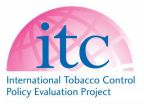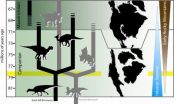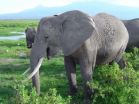(Press-News.org) Researchers at the European Molecular Biology Laboratory (EMBL) in Grenoble, France, have determined the detailed 3-dimensional structure of part of the flu virus' RNA polymerase, an enzyme that is crucial for influenza virus replication. This important finding is published today in PLoS Pathogens. The research was done on the 2009 pandemic influenza strain but it will help scientists to design innovative drugs against all the different influenza strains, and potentially lead to a new class of anti-flu drugs in the next 5-10 years.
The scientists focused on the endonuclease part of the viral RNA polymerase. The endonuclease is responsible for a unique mechanism called 'cap-snatching' that allows the virus to trick its host cell into producing viral proteins. In human cells the translation of messenger RNA (mRNA) strands into proteins requires a special structure, called the "cap", at the beginning of each mRNA. When the influenza virus infects a host cell its endonuclease "snatches" that cap from the cell's own mRNA. Another part of its RNA polymerase then uses it as the starting point for synthesizing viral mRNA. With the correct cap structure at the beginning, viral mRNA can then hijack the protein-production machinery of the infected cell to make viral proteins, which assemble into new viruses that will spread the infection.
The team led by Stephen Cusack, Head of EMBL Grenoble, analyzed crystals of endonuclease from the 2009 pandemic influenza strain using the high intensity X-ray beams at the European Synchrotron Radiation Facility (ESRF). The researchers were able to determine the 3D atomic structure of the enzyme and to visualize how several different small molecule inhibitors bind to and block its active site. If the active site of the endonuclease is blocked by an inhibitor the enzyme cannot bind its normal substrate, the host cell mRNA, and viral replication is prevented.
The active site of the endonuclease is shaped like a cave with two metal ions at the bottom. Cusack and colleagues found that all the inhibitors they studied bind to those two metal ions but, depending on their shapes, different inhibitors bind differently to the amino-acids of the cave's walls.
"Based on this detailed structural information we can now design new synthetic chemicals which bind even more tightly to the endonuclease active site and thus will potentially be more potent inhibitors of influenza virus replication," explains Stephen Cusack. "We can even try to build in anti-drug resistance by making sure the inhibitors only contact those amino acids that the virus cannot mutate since they are essential for the normal activity of the polymerase."
Because the cap-snatching mechanism is common to all influenza strains, new potent endonuclease inhibitors should be effective against seasonal flu, novel pandemic strains or highly pathogenic H5N1 bird flu. EMBL scientists are working with EMBL's spin-off company Savira pharmaceuticals, in partnership with Roche, to further develop influenza inhibitors. Promising candidates will be tested first for efficacy in cell culture, ultimately moving into clinical trials on humans.
###This research was partly funded by the European commission, through the FP7 research grant awarded to the FluPharm project.
Catching the cap-snatcher
Structural analysis opens the way to new anti-influenza drugs
2012-08-03
ELSE PRESS RELEASES FROM THIS DATE:
Aerial photos reveal dynamic ice sheet
2012-08-03
Despite the current and rapid melting of the Greenland Ice Sheet, it remains far from certain just when we will have reached a point when scientists will be able to predict its disappearance. Recent research conducted by the University of Copenhagen in conjunction with the Technical University of Denmark (DTU) and the Danish National Survey and Cadastre (KMS) in collaboration with an international team of scientists reports that this is not the first time in recent history that the ice sheet has been in retreat and then stabilised again. The researchers' results have just ...
Alzheimer's cognitive decline slows in advanced age
2012-08-03
The greatest risk factor for Alzheimer's disease (AD) is advancing age. By age 85, the likelihood of developing the dreaded neurological disorder is roughly 50 percent. But researchers at the University of California, San Diego School of Medicine say AD hits hardest among the "younger elderly" – people in their 60s and 70s – who show faster rates of brain tissue loss and cognitive decline than AD patients 80 years and older.
The findings, reported online in the August 2, 2012 issue of the journal PLOS One, have profound implications for both diagnosing AD – which currently ...
Plant-based compound slows breast cancer in a mouse model
2012-08-03
The natural plant compound phenethyl isothiocyanate (PEITC) hinders the development of mammary tumors in a mouse model with similarities to human breast cancer progression, according to a study published August 2 in the Journal of the National Cancer Institute.
Edible plants are gaining ground as chemopreventative agents. PEITC has shown to be effective as a chemopreventative agent in mice for colon, intestinal, and prostate cancer, by inducing apoptosis.
In order to determine the efficacy of PEITC in mammary tumors in mice, Shivendra V. Singh, Ph.D., of the University ...
Cuckoo tricks to beat the neighborhood watch
2012-08-03
To minimise the chance of being recognised and thus attacked by the birds they are trying to parasitize, female cuckoos have evolved different guises. The new research, funded by the Natural Environment Research Council, was published today, 03 August, in the journal Science.
The common cuckoo (Cuculus canorus) lays its eggs in the nests of other birds. On hatching, the young cuckoo ejects the host's eggs and chicks from the nest, so the hosts end up raising a cuckoo chick rather than a brood of their own. To fight back, reed warblers (a common host across Europe) have ...
Breast cancer charity under fire for overstating the benefits of screening
2012-08-03
Professors Lisa Schwartz and Steven Woloshin of the Center for Medicine and the Media at The Dartmouth Institute for Health Policy and Clinical Practice argue that last year's breast cancer awareness month campaign by Susan G Komen for the Cure "overstates the benefit of mammography and ignores harms altogether."
Their views are published on bmj.com today as part of an occasional series highlighting the exaggerations, distortions, and selective reporting that make some news stories, advertising, and medical journal articles "not so."
A growing and increasingly accepted ...
5-year survey confirms Uruguay's world-leading tobacco control strategy is delivering results
2012-08-03
Implementation of graphic labels at 80% of the pack size front and back led to increased awareness of the risks of smoking
Ban on multiple brand presentations reduced smokers' false beliefs that some cigarettes (e.g., "light" or "mild" cigarettes) are less harmful
Strong support for tobacco control policies among smokers
(Thursday August 2nd, 2012, Montevideo, Uruguay and Waterloo, Ontario, Canada): The International Tobacco Control Policy Evaluation Project (the ITC Project) today launched a new report on the effectiveness of tobacco control policies in Uruguay. ...
Mountains, seaway triggered North American dinosaur surge
2012-08-03
ATHENS, Ohio (Aug. 2, 2012)—The rise of the Rocky Mountains and the appearance of a major seaway that divided North America may have boosted the evolution of new dinosaur species, according to a new Ohio University-led study.
The finding, published today in the journal PLOS ONE, may explain patterns of evolution and migration of North American duck-billed and horned dinosaurs in the years leading up to their extinction 65 million years ago, said Terry Gates, a postdoctoral researcher with Ohio University's Heritage College of Osteopathic Medicine who is lead author on ...
Close to the bone
2012-08-03
A genetic screening approach to studying bone disease has found nine new genes associated with bone health and suggests a new way to discover genes that may be implicated in human skeletal diseases. A collaborative study of the mineral content, strength and flexibility of bones has found clues to the cause of bone disorders such as osteoporosis, osteogenesis imperfecta, and high bone density syndromes. The study, which brings together specialist skills in mouse gene deletion and bone measurement to assess the strength of bones in 100 mutant mouse lines, is the largest ...
Modest weight loss can have lasting health benefits, research shows
2012-08-03
ORLANDO, Fla. – Overweight and obese individuals can achieve a decade's worth of important health benefits by losing just 20 pounds, even if they regain the weight later that decade, according to research presented at the American Psychological Association's 120th Annual Convention. With a focus on psychology's role in overcoming the national obesity epidemic, the session also examined research that indicates foods high in sugar and fat could have addictive properties.
Rena Wing, PhD, professor of psychiatry and human behavior at Brown University's Alpert Medical School ...
Study shows how elephants produce their deep 'voices'
2012-08-03
African elephants are known to be great communicators that converse with extremely low-pitched vocalizations, known as infrasounds, over a distance of miles. These infrasounds occupy a very low frequency range—fewer than 20 Hertz, or cycles, per second—that is generally below the threshold of human hearing.
Now, a new study shows that elephants rely on the same mechanism that produces speech in humans (and the vocalizations of many other mammals) to hit those extremely low notes. Christian Herbst from the University of Vienna, along with colleagues from Germany, Austria ...
LAST 30 PRESS RELEASES:
$80 million in donations propels UCI MIND toward world-class center focused on dementia
Illinois research uncovers harvest and nutrient strategies to boost bioenergy profits
How did Bronze Age plague spread? A sheep might solve the mystery
Mental health professionals urged to do their own evaluations of AI-based tools
Insufficient sleep associated with decreased life expectancy
Intellicule receives NIH grant to develop biomolecular modeling software
Mount Sinai study finds childhood leukemia aggressiveness depends on timing of genetic mutation
RSS Research Award for new lidar technology for cloud research
Novel AI technique able to distinguish between progressive brain tumours and radiation necrosis, York University study finds
Why are abstinent smokers more sensitive to pain?
Alexander Khalessi, MD, MBA, appointed Chief Innovation Officer
Optical chip pioneers physical-layer public-key encryption with partial coherence
How your brain understands language may be more like AI than we ever imagined
Missed signals: Virginia’s septic strategies overlook critical timing, study warns
Delayed toxicities after CAR T cell therapy for multiple myeloma are connected and potentially preventable
Scientists find cellular key to helping plants survive in saltwater
Medical cannabis program reduces opioid use
Immunotherapy works for sepsis thanks to smart patient selection
Cardiovascular events 1 year after RSV infection in adults
US medical prices and health insurance premiums, 1999-2024
Medical cannabis and opioid receipt among adults with chronic pain
Multichannel 3D-printed bioactive scaffold combined with siRNA delivery for spinal cord injury recovery
Triaptosis—an emerging paradigm in cancer therapeutics
A new paradigm in spectroscopic sensing: The revolutionary leap of SERS-optical waveguide integration and ai-enabled ultra-sensitive detection
Sweet tooth: How blood sugar migration in diabetes affects cavity development
Lowest suicide rate is in December but some in media still promote holiday-suicide myth
Record-breaking cosmic explosion challenges astronomers’ understanding of gamma-ray bursts
Excessive heat harms young children’s development, study suggests
Quanta Books to publish popular math and physics titles by Terence Tao and David Tong
Philanthropic partnerships fund next-generation instruments for mid-sized telescopes
[Press-News.org] Catching the cap-snatcherStructural analysis opens the way to new anti-influenza drugs


